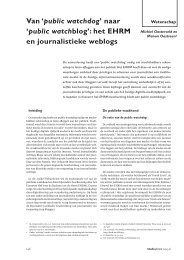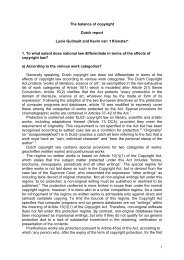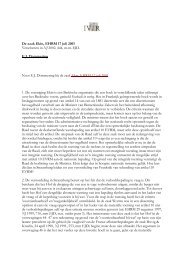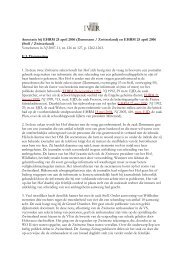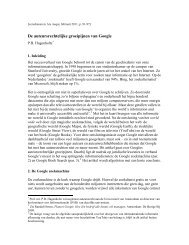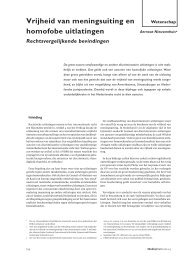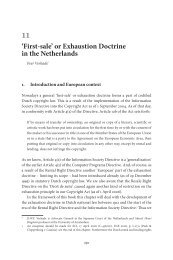ADAPTING COPYRIGHT TO THE INFORMATION ... - IViR
ADAPTING COPYRIGHT TO THE INFORMATION ... - IViR
ADAPTING COPYRIGHT TO THE INFORMATION ... - IViR
You also want an ePaper? Increase the reach of your titles
YUMPU automatically turns print PDFs into web optimized ePapers that Google loves.
notions.' 39<br />
Indeed, it seems inevitable that the digital networked environment will eventually<br />
necessitate more radical changes to the copyright system. Arguably, a long-term revision<br />
of the copyright system is necessary - not only to insure adequate protection to<br />
rightholders, but also to protect the legitimate interests of users of protected works.<br />
Overstretching `old media notions', such as the right of reproduction, obviously bears the<br />
risk of overprotection.<br />
Contours of a new law<br />
Any future over-all revision of the copyright system must take into account the specific<br />
nature of the communication process of the digital networked environment, as well as the<br />
peculiar economics of providing, distributing and using information on the network. In<br />
the future, exclusive rights on the superhighway must no longer be (solely) based on<br />
expanded notions of copying and reproduction, but be redefined so as to become<br />
`network-oriented' 40<br />
Thus, the new law must be built on a sound analysis of the economics of digital network<br />
dissemination. Unfortunately, many legislators and scholars seem to be losing sight of<br />
the economic underpinnings of the existing set of exploitation rights. A dogmatic<br />
preoccupation with merely technical acts of reproduction may result in an unwanted<br />
proliferation of the copyright monopoly.<br />
Moreover, the new law must be made `multimedia proof' as much as possible. The<br />
emerging multimedia environment is rapidly making technology specific rulemaking,<br />
either within or outside the framework of intellectual property, obsolete. As<br />
heterogeneous categories of works, specific media and technologies `converge' into a<br />
homogeneous multimedia environment, existing regulatory distinctions between specific<br />
work categories, media or technologies will be increasingly difficult to maintain.<br />
Finally, the new law must respect fundamental rights and freedoms of users and<br />
intermediaries. In this context, it is unfortunate that considerations of informational<br />
privacy and freedom of expression are virtually absent from the European Commission's<br />
Green Paper. Clearly, these basic freedoms are at stake, if, as the Green Paper seems to<br />
suggest, the economic rights of rightholders were to be stretched to comprise acts of<br />
intermediate transmission and transient reproduction, as well as acts of private viewing<br />
and use of information.<br />
Even so, a clear picture of the future of copyright in the digital environment does not<br />
emerge from the previous discussions. This should come as no surprise. The<br />
superhighway is a multi-purpose, multi-user, multimedia environment, capable of<br />
delivering in a variety of ways almost the complete Berne Convention catalogue of<br />
works. The copyright problems of the superhighway, then, are the problems of the entire<br />
information and entertainment industry. To these there are no quick and easy answers. In<br />
the context of this paper, only a few of these problems have been addressed, with a<br />
special view to offering short-term solutions to the European legislator.<br />
39 P. Geller, supra note 10, 58.<br />
40 Cf. Dommering, supra note 4, passim.


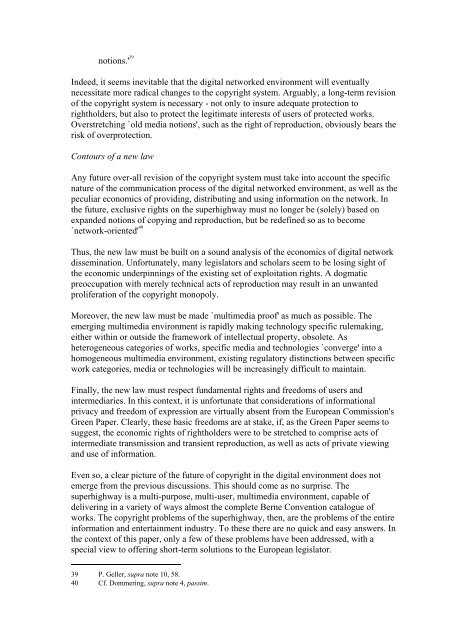
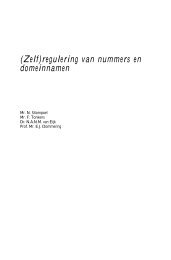
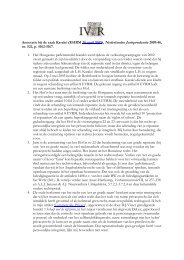

![Legal Opinion of Professor Egbert Dommering [1] concerning ... - IViR](https://img.yumpu.com/23603085/1/184x260/legal-opinion-of-professor-egbert-dommering-1-concerning-ivir.jpg?quality=85)
